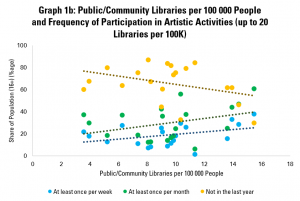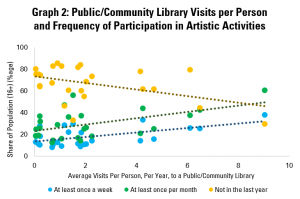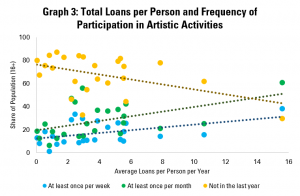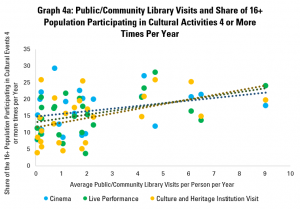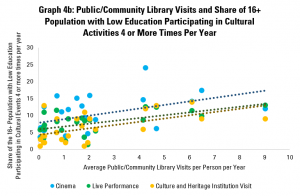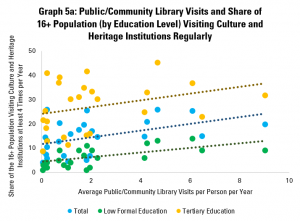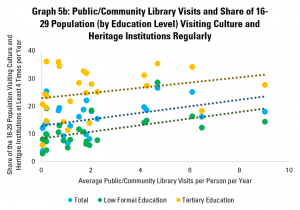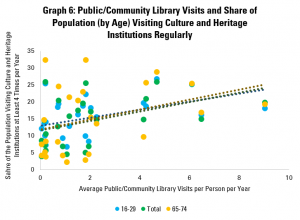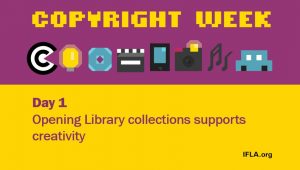A vital component in realizing cultural rights, including freedom of expression and participation in cultural life, is supporting cultural actors. This includes those working in the creation, production, and distribution of, as well as access to, expressions of culture.
So, with 2021 being the International Year of Creative Economy for Sustainable Development, IFLA has explored how libraries open the door to cultural participation and make space for cultural diversity.
This includes work to do so by providing access to lifelong learning opportunities and addressing gaps in the ability to participate in culture on digital platforms, as well as fostering environments where diverse cultural expressions are encouraged, valued, shared, and protected.
To prepare this overview, IFLA engaged with several of our Professional Units and carried out desktop research to find concrete examples of how libraries put these values into action. We have found examples ranging from libraries participating in national cultural strategies to carrying out community-level programmes. Some examples help elevate established creators, while others create spaces where new creators can explore and grow.
Let’s take a deeper look at how libraries can act as incubators of creativity and the creative economy in their national contexts.
Libraries as Partners: Contributing to Government Initiatives
Brazil: National Reading and Writing Policy
In 2018, the Brazilian Special Secretariat for Culture established, within the National Reading and Writing Policy, a permanent strategy to promote books, reading, writing, literature, and publicly accessible libraries (Law No. 13,696/2018) [source]. The Brazilian National Library Foundation is engaged as a partner in this strategy.
The Policy’s objectives include promoting access to books and reading, disseminating Brazilian literature, and valuing and encouraging national authors with an emphasis on bibliodiversity.
Initiatives carried out within this framework have helped stimulate the creative economy by supporting national authors through funding and participation in international literacy fairs.
For example, in 2018, a public call for original works in Portuguese on select themes regarding the history of Brazil was circulated. Fifty works were selected for funding, which contributed to promotion and dissemination efforts.
Colombia: Reading Colombia
The National Library of Colombia partnered with the Ministry of Culture, Vice-ministry of Creativity and Orange Economy and the Colombian Book Chamber on the “Reading Colombia” strategy [source].
A key focus of this strategy was to support the distribution of works by national authors in the international market in order to help increase visibility of contemporary Colombian writers.
In 2018, the scheme awarded 12 scholarships to support translation of the work of Colombian authors into six languages. In 2019, this increased to 50 works of Colombian literature.
Ireland: Decade of Centenaries Programme
The Decade of Centenaries 2012-2023 has been an ongoing programme administered by the Irish Department of Tourism, Culture, Arts, Gaeltacht, Sport and Media to commemorate the 100-year anniversary of the most difficult and transformative period of Irish history, 1912-1923.
The National Library of Ireland is partnering with Department and the Decade of Centenaries Programme to appoint a poet in residence to engage with this theme and create original works [source].
This year-long post is supported by a stipend. During this time, the poet will not only create original literary works, but contribute to masterclasses for practitioner-led, experimental or interdisciplinary programmes, participate in workshops to help engage new audiences with the Library’s collections, and work to develop good practice outreach models to connect their creative works with a public audience.
United States of America: Library of Congress National Book Festival
The National Book Festival is hosted annually by the Library of Congress, the national library of the USA. Over past years, more than 100 authors, poets, and illustrators had the opportunity to connect with over 200,000 attendees for book talks, discussions, book signings and other engaging activities.
This has historically been the largest annual literary gathering held in the nation’s capital but in 2021 will reach a much wider audience through a hybrid in-person / online programme.
Content will be available through videos on-demand, author conversations in real time and live question-and-answer sessions, as well as a podcast series, a national television special, and in-person events at the Library.
This Festival will also engage authors from across the 50 states, the District of Columbia, Puerto Rico and the U.S. Virgin Islands, who are each invited to choose a book to represent their state or territory’s literary heritage. The Library of Congress will amplify these authors by holding conversations to discuss their books and what they mean for each State or Territory.
Libraries as Hosts: Artists in Residence
Jamaica: National Library of Jamaica Poet Laureate Programme
The Poet Laureate selected by the National Library of Jamaica carries out a three-year term, during which time he or she is tasked with stimulating a wider appreciation for Jamaican poetry. During this time, the Poet Laureate also helps encourage public involvement in poetry and spoken word arts, including by involving young people in appreciating and writing poetry. The scheme supports the poet during their term through a grant [source].
Within this programme, the Poet Laureate presents their own creations both locally and abroad, is involved in national events, and carries out participatory programmes to encourage developing poets, such as poetry competitions and school poetry reading tours [source].
United States of America: University of California San Francisco Library Artist in Residence program
This programme, carried out by the University Library, invites artists to promote health humanities through creative use of the historical materials preserved in the Library’s Archives and Special Collections [source].
The current Artist in Residence, Farah Hamaden, is a biomedical illustrator and animator, whose interactive storytelling project, “The City is a Body”, seeks to collect and bring to life San Franciscans’ experiences during the COVID-19 pandemic. Find out more about her project here.
Singapore – The National Library Board Creative Residency
This programme invites creatives from all different artistic disciplines to use the National Library Board’s collections to inspire their own works, and to reimagine them in ways that help engage a wider community with the collection [source].
Creative work produced in this role can take the form of videos, publications, literary works, artworks, musical compositions, or more. The 6-month post is supported by a stipend, and is open to all Singapore-based creative practitioners (individuals or collectives) working in any discipline or form of expression to apply.
Libraries as Enablers: Supporting New Creators
Trinidad and Tobago – NALIS First Time Authors Programme
National Library and Information Systems Authority (NALIS) highlights first-time authors of Trinidad and Tobago nationality or descent through their First Time Authors Programme [source].
Held on World Book and Copyright Day, this programme celebrates the accomplishment of first time authors, encourages new national writers, and raises public awareness of issues relating to intellectual property and copyright.
During the annual ceremony, national first-time authors of all genres are presented with appreciation tokens and their work is promoted online. See a recent example here.
Australia: Yarra Plenty Regional Library Maker Spaces and Maker Month
Yarra Plenty Regional Library (YPRL), a public library service located in Melbourne, Australia, has established Maker Spaces in 6 of their 9 branches. These spaces allow users to create, connect, collaborate, and learn in a fun and supported environment, and specialise in areas of textile and craft, mental health, gardening, writing and publishing, science and technology, and design
In 2020, the library launched a month-long, region-wide Maker Month programme. This went beyond the Maker Spaces, with a focus on entrepreneurs and events to support and empower those starting out in business or making the leap from hobby to “side hustle”.
This addressed an identified gap for support systems aimed at such microbusinesses, with many not knowing where to start in launching their own creative small business. Built on community feedback, the programme offered local makers opportunities to connect and network, get creative, and upskill. It provided tools to learn about business needs – from developing their idea to running and marketing their business.
Although hampered by the outbreak of the pandemic, many programmes were held online. These included topics such as: Using WordPress to make your own webpage, How and why to create digital content for your business, and How to plan for small businesses.
A number of sessions, including Turning Your Passion into Profit and How to Market Your Business Using Social Media continue to run in an online format.
The library is planning a smaller-scale Maker Month for July 2021, with a mix of online and in-person events including 90-day Business Planning and is launching a co-working space which will have an ongoing focus on business support.
****
This is just a look at different ways libraries can make a difference for creative actors, connecting them with opportunities to create, elevating and promoting their work, and encouraging learning and exploration.
Through their position in the social fabric and their role as champions of access to information and freedom of expression, it is clear that libraries are an essential piece in a thriving creative economy.
Through examples such as these, libraries contribute to the fulfillment of cultural rights and link them to economic opportunity for creative actors – both of which are needed to enable sustainable development.
This list is by no means exhaustive – we welcome additional cases from all types of libraries around the world! Send your stories to: claire.mcguire@ifla.org

